Family : Felidae

Text © Dr Didier Hallépée

English translation by Mario Beltramini
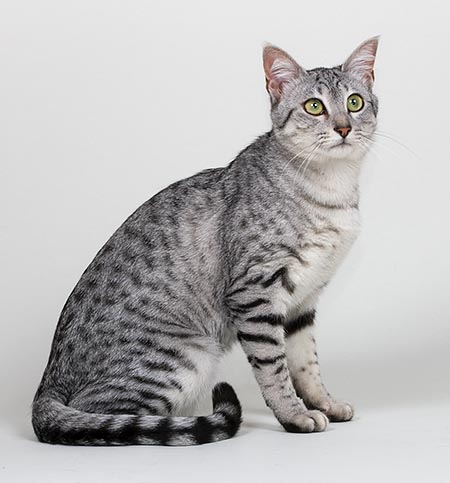
The Egyptian Mau is the Pharaohs’ famous sacred cat © Giuseppe Mazza
Due to the Second World War, many cats died in Italy and the direct descendants of the pharaoh’s cats had practically disappeared. Nevertheless, maculated cats are still found in Italy, and as they say, also in Provence. In the movie “The Horseman on the Roof” (199-Jean-Paul Rappeneau), the feline hero has all the characteristics of the bronze mau.
On the contrary, the brown cat maculated of black seems to be still rather common in North Africa. Road cats looking like the bronze mau have been sighted up to Morocco. On the other side of Egypt, this kind of cat can be found also all along the Silk Road.
Nathalie Troubetzkoï was an exiled Russian princess brought to live in Rome by the cases of the life. Nathalie was really fond of cats. One day, a young boy took to her a kitten inside a carton box. The unusual beauty of this kitten did conquer her at once. The kitten was named Ludivine and nicknamed Ludol or Lulu. Lulu had a nice silver colour with black spots. The princess noted that the box which had contained the kitten was coming from Egypt. It is in this way that she deduced the origin of this wonderful cat. She had quickly understood that she had met a descendant from the cats of the Pharaoh.
She alerted her numerous friends to find her another cat of this type in order to get newborns of the same look. Some friends found her Gregorio, a black male, 11 years old, coming from a maculated family. Her friend, the ambassador of Syria, brought her an authentic specimen from the near East, Geppa, a black smoke male.
Lulu and Geppa soon generated the first brood (1953) which was similarly maculated as the parents. Among them, Nathalie Troubetzkoï kept a small silver female, Baba. Later on, Gregorio made to Baba some magnificent kitten, also maculated (1953), with, between them, a cat with a new colour, Jojo, a bronze. Nathalie Troubetzkoï began to render her cats known in Italy and went on in getting them reproduced. Liza (or Donna Lisa) was presented in a contest in Rome on 1955.
In 1956, she was, at last, authorized to emigrate in USA. As she could not take all her cats, she had to choose three of them and found a house for the others. It’s in this way that Baba, Jojo and Liza left to the conquest of the United States.
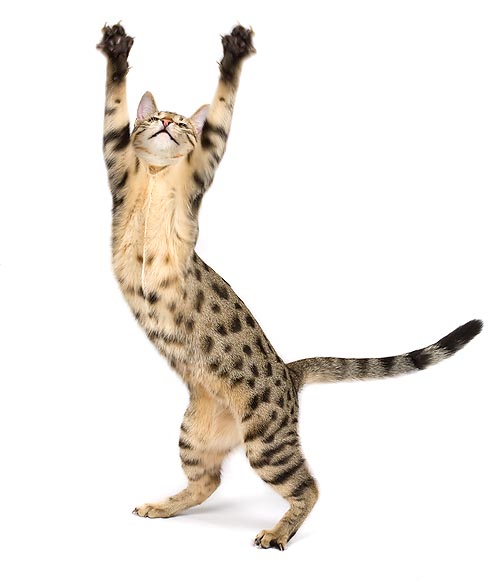
When a cat dances a rock, it’s maybe a bronze Egyptian Mau © Giuseppe Mazza
Once installed there, Nathalie Troubetzkoï went on in promoting the Egypt cats, exposing them and introducing them as a race under the name of the Egyptian Mau. She created her own breeding under the name of Fatima cat house. In 1957, Baba was the first specimen of the race to be crowned champion. All bred Egyptian maus descend from the maus of the princess.
To breed a race starting from 3 original specimens is not an easy thing. Consequently, during several years, the breeding of the Egyptian mau has been concerned by the consanguinity problems in spite of few external contributions.
In order to find a final solution to the consanguinity problems, Didier and Marie-Christine Hallépée have reintroduced specimens coming directly from Cairo: Sahourê, Otta and Maslama, which has permitted to keep the natural beauty and the endearing personality of the mau giving it in the same time the best robustness and a health. All the progenies present in France take advantage from these contributions which are found also in several foreign parentages.
Since the fifties, the British have been seduced by the Maus. Limited in their importation by the quarantine, they tried to “recreate” the race starting from hybrids of Abyssinians, tabbies and Siamese cats. Initially, these cats were called maus, but they were finally recognized as a specific eastern variety: the Oriental spotted tabby.
That is why in some badly informed texts, we can at times read that the mau descends from the Siamese and that their morphologies are alike. Some errors are hard to pass away….
THE CARACTER
The Egyptian mau is often qualified as a cat-dog. It is really sticky, does not hesitate in following you wherever you go I the house during the house works. Breakfast is a very interesting activity: after a long night, at last you are available for the so much longed endearments session. This adorable mau cat will then climb on your knees and will rub against your arm which, in the same time, will desperately be trying to control the path described by you cup of well warmed coffee! The evening, while watching TV, you will suddenly realize that it is lying and dozing on your knees without your knowledge!
Often, it looks at you and with its eyes it can transmit many messages. It does not mew too noisily, but modulates the voice and is able to express many things. Some progenies are shyer than others. These shy cats have the tendency to run away from those they do not recognize as members of the family. They are often cats belonging to one person only. When a visitor is present, they move to another room or hide under a piece of furniture. They are no attracted by the vast spaces: they prefer a well reassuring small home. It is during the quietness of the evening that even the most timid come and lay on the bed and finally get their caresses. These ones are not there for attracting the admiration of visitors. They are there for giving a true affection to the master who deserves it.
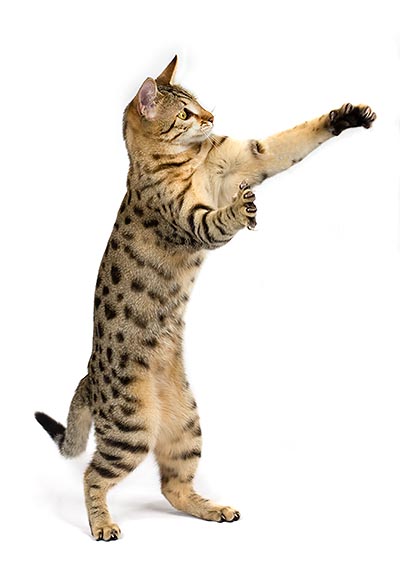
A bronze Egyptian Mau has a more or less warm color © Mazza
It is not a fuzz-ball! When playing or trying to escape from you (no, mum, you will not give me my medicines!), it is almost impossible to be seized. Under its belly, there is a piece of skin hanging down, the belly pocket.
This poach allows the cat to better lengthen when running or jumping. In this way, it can jump for more than two metres or run at more than 50 km/h.
Well, not all: when the poach is well full, the cat loses its agility…
The mau has a very strong personality though very tender, little shy or semi-savage (like those living free in Egypt).
A relationship mixed of affection and respect settles between the two of you. Impossible to ignore it or its desires. The mau in need of caresses will not stop till when it gets them.
The mau requiring the respect of its tranquillity, will be able to convince you that you have the right to get close, talk, have a personalized approach but do not have the right of touching it and will assume an indignant countenance if the status quo is not respected.
For what concerns the one who has chosen to love you above all, when the time of the hated cares comes, it will wriggle, scream, show it could defend … and will avoid causing any harm to you!
There is also the little savage born in Egypt which has adopted you. Its presence and affection are such that you have to exert an effort for keeping in mind you cannot hold it in your arms.
Finally, there is the wise one: its personality if a relaxing one. It lays against cats, dogs and humans and clams down also the most excited of them. The cat is already known for being an animal with a strongly expressive personality. This is a character particularly remarkable of the mau.
THE STANDARD OF THE MAU
The Egyptian Mau is a naturally maculated race of domestic cats. This mid-size cat which combines power and elegance impresses for the surprising contrast of its short and glossy mantle and for the expression of its bright green eyes. Medium-sized, the head forms a triangle with soft outline without any even face. Seen from the front, the cheeks are level, but the males, where the flabby cheeks are accepted. The nose has the same width all over its length. Seen from the side, the front is slightly rounded and prolonged by a slight concave slant at the level of the eyes. The nose is straight. Neither short nor long, the muzzle, all with gentle curves, completes the triangle of the head. The chin is solid, neither protuberant nor hollow. Almond-shaped, the eyes are big and well open with a slightly askew form but without being oriental. The best colour is called “green gooseberry”.
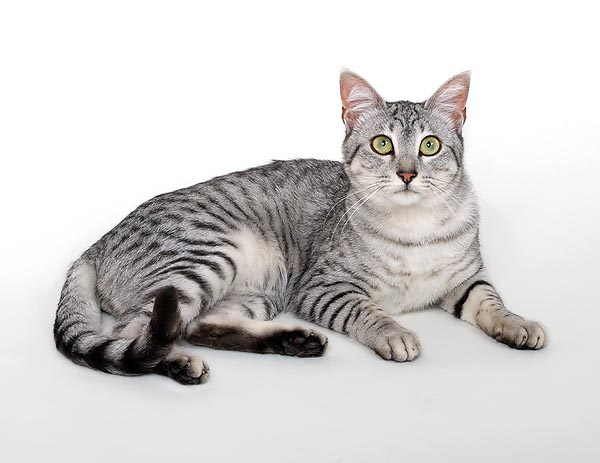
Silver is the most common colour in the Egyptian Maus © Giuseppe Mazza
Of medium to big size, the ears are wide at the base, rounded on the tip and placed rather spaced on the extension of the lines formed by the head. Seen from the side, they are rather backward placed.
The exterior of the ears is covered by a very short fur, whilst the interior, pale pink, is almost transparent. The neckline is bent, well marked.
Of semi-foreign type, the body, of medium size, is an harmonious combination which joins power to elegance.
The shoulders are projecting, and their angle is easily perceived.
The muscles are well developed, especially on the adult males which can be square-built than the females.
Between the back limbs, the typical ventral poach is required.
Of medium size, the limbs have a moderate bony framework and a strong musculature.
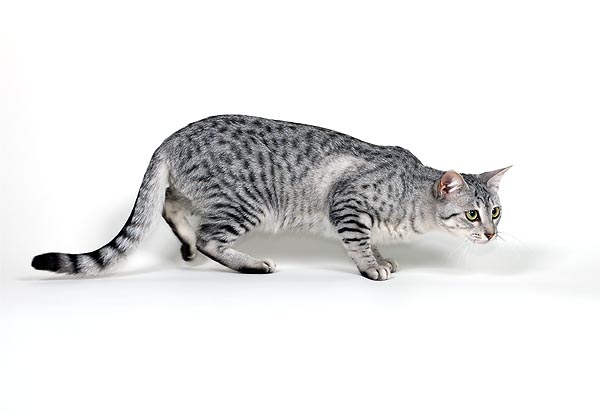
The coat of the Egyptian Mau is typically spotted © Giuseppe Mazza
The back limbs, higher than the anterior ones, grant a particular balance to the Egyptian Mau which, when erect, seems to stand on the tiptoes. Small and delicate, the feet are slightly oval, almost rounded.
Of medium size, the tail is somewhat thick at the base and then gets thinner towards the extremity. Short, the fur must in any case have a sufficient length to allow each single hair (in the maculated zones) to have at least four alternate bands, clear and dark. It is well distributed along the body.
In the silver and the bronze, it is gentle and elastic to the touch. In the black smoke and black, it is thinner and silky.
The patron spotted tabby only is accepted. There must be a good contrast between the pale colour of the background of the hair and the marks of the deepest colour.
The front has the characteristic “M” of the tabbies, and the eye, the typical Egyptian makeup. A second line placed under the makeup fades away towards the ear. Some well marked straight lines originate from the M on the skull, go through the neck and become well aligned spots on the spine.
The marks are wider on the shoulders, thus making the transition between the lines and the spots. The rest of the body is covered by variable size and form dots, but never lined in order not to recall the mackerel tabby pattern. The neck is decorated by at least one open collar and the belly has some spots placed like “button vests”.
The limbs often have some thick rings which can be different and open. The tail has also rings, with black tip but the bronze, where it can be from dark brown to black.
Coat
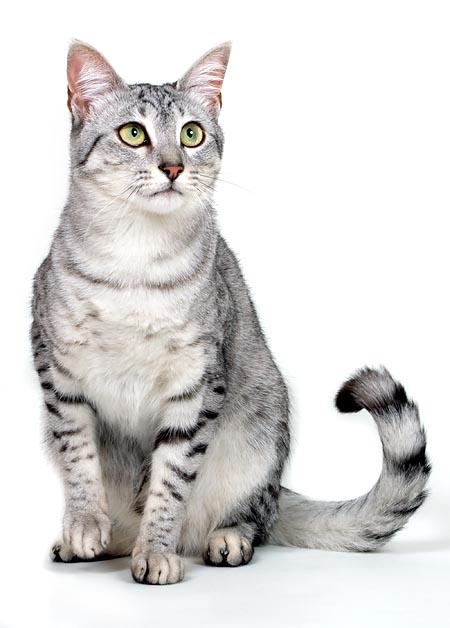
The Egyptian Mau is discreet, expressive, shy at times © Giuseppe Mazza
Bronze. Bronze base, brilliant, fading from chamois to ivory under the belly, darker on the hind and contrasting with black or dark brown dots. A grey undercoat is accepted. The back of the ears is pink fawn with dark brown to black points. The throat, chin and nostrils go from the cream white to the beige. The truffle is brown red. The pads are dark brown to black with the same colour between the toes and the back of the rear limbs. According to some standards, the Egyptian Mau can have more or less of a copper tint.
Black smoke (Pewter). Even if not sharp, the black smoke colour in the Egyptian Mau must allow the patron spotted tabby (ghost marks) to express clearly. The base of the hair is bright silver for a quarter of its length; the remaining three quarters are anthracite gray. The coloured dots on the three quarters of the hair are black and in this way they contrast with the rest of the mantle. The throat, chin and nostrils are clearer. The nose, lips and eyes are underlined in black. The truffle and the pads are black, with some black around the toes and on the back of the rear limbs.
Black. Even if not sharp, the black colour of the Egyptian Mau can allow the patron spotted tabby (ghost marks) to express. The hair is bright on all its length.
Blue. The blue colour is recognized solely in CFA in its four varieties (blue silver, blue self, blue smoke, blue solid).
Shirazi. The longhaired mau, bred under the name of shirazi, is not recognized.
→ For general notions about Felidae please click here.
→ To appreciate the biodiversity within the CAT BREEDS please click here.
